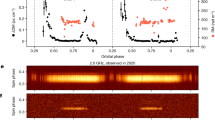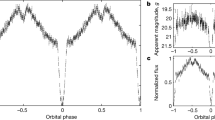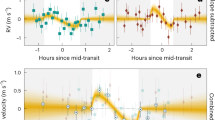Abstract
It has long been suspected that tidal forces in close binary stars could modify the orientation of the pulsation axis of the constituent stars. Such stars have been searched for, but until now never detected. Here we report the discovery of tidally trapped pulsations in the ellipsoidal variable HD 74423 in Transiting Exoplanet Survey Satellite (TESS) space photometry data. The system contains a δ Scuti pulsator in a 1.6 d orbit, whose pulsation mode amplitude is strongly modulated at the orbital frequency, which can be explained if the pulsations have a much larger amplitude in one hemisphere of the star. We interpret this as an obliquely pulsating distorted dipole oscillation with a pulsation axis aligned with the tidal axis. This is the first time that oblique pulsation along a tidal axis has been recognized. It is unclear whether the pulsations are trapped in the hemisphere directed towards the companion or in the side facing away from it, but future spectral measurements can provide the solution. In the meantime, the single-sided pulsator HD 74423 stands out as the prototype of a new class of obliquely pulsating stars in which the interactions of stellar pulsations and tidal distortion can be studied.
This is a preview of subscription content, access via your institution
Access options
Access Nature and 54 other Nature Portfolio journals
Get Nature+, our best-value online-access subscription
$29.99 / 30 days
cancel any time
Subscribe to this journal
Receive 12 digital issues and online access to articles
$119.00 per year
only $9.92 per issue
Buy this article
- Purchase on Springer Link
- Instant access to full article PDF
Prices may be subject to local taxes which are calculated during checkout




Similar content being viewed by others
Data availability
TESS photometric data are publicly available at the Mikulski Archive for Space Telescopes (MAST, https://mast.stsci.edu/portal/Mashup/Clients/Mast/Portal.html). All relevant data are also available by request from the corresponding author.
Code availability
The codes for computing the discrete Fourier transform and to carry out the variability analyses are available on request from D.W.K. The SPECTRUM code used to compute synthetic spectra is publicly available from http://www.appstate.edu/~grayro/spectrum/spectrum.html.
References
Torres, G., Andersen, J. & Giménez, A. Accurate masses and radii of normal stars: modern results and applications. Astron. Astrophys. Rev. 18, 67 (2010).
Aerts, C., Christensen-Dalsgaard, J. & Kurtz, D. W. Asteroseismology (Springer, 2010).
Cowling, T. G. The non-radial oscillations of polytropic stars. Mon. Not. R. Astron. Soc. 101, 367–375 (1941).
Handler, G. et al. Discovery and analysis of p-mode and g-mode oscillations in the A-type primary of the eccentric binary HD 209295. Mon. Not. R. Astron. Soc. 333, 262–279 (2002).
Welsh, W. F. et al. KOI-54: the Kepler discovery of tidally excited pulsations and brightenings in a highly eccentric binary. Astrophys. J. 197, 4 (2011).
Thompson, S. E. et al. A class of eccentric binaries with dynamic tidal distortions discovered with Kepler. Astrophys. J. 753, 86 (2012).
Hambleton, K. M. et al. KIC 4544587: an eccentric, short-period binary system with δ Sct pulsations and tidally excited modes. Mon. Not. R. Astron. Soc. 434, 925–940 (2013).
Hambleton, K. M. et al. KIC 8164262: a heartbeat star showing tidally induced pulsations with resonant locking. Mon. Not. R. Astron. Soc. 473, 5165–5176 (2018).
Balona, L. A. On the amplitude decrease of the β Cephei stars Spica and 16 Lacertae. Mon. Not. R. Astron. Soc. 217, 17P–21P (1985).
Kurtz, D. W. Rapidly oscillating Ap stars. Mon. Not. R. Astron. Soc. 200, 807–859 (1982).
Ledoux, P. The nonradial oscillations of gaseous stars and the problem of beta Canis Majoris. Astrophys. J. 114, 373–384 (1951).
Bigot, L. & Kurtz, D. W. Theoretical light curves of dipole oscillations in roAp stars. Astron. Astrophys. 536, A73 (2012).
Pesnell, W. D. Observable quantities of nonradial pulsations in the presence of slow rotation. Astrophys. J. 292, 238–248 (1985).
Lenz, P. Asteroseismology of stars on the upper main sequence. Proc. Sci. 149, 3 (2011).
Houk, N. & Cowley, A. P. Catalogue of Two-dimensional Spectral Types for the Hd Stars. Volume I. Declinations −90 to −53 (Univ. Michigan, 1975).
Bernhard, K., Hümmerich, S., Otero, S. & Paunzen, E. A search for photometric variability in magnetic chemically peculiar stars using ASAS-3 data. Astron. Astrophys. 581, A138 (2015).
Pojmański, G. The All Sky Automated Survey. Catalog of variable stars. I. 0h–6h quarter of the Southern Hemisphere. Acta Astron. 52, 397–427 (2002).
Gray, R. O. et al. The discovery of λ Bootis stars: the southern survey I. Astron. J. 154, 31 (2017).
Lindegren, L. et al. Gaia data release 2. The astrometric solution. Astron. Astrophys. 616, A2 (2018).
Ekström, S. et al. Grids of stellar models with rotation. I. Models from 0.8 to 120 M ⊙ at solar metallicity (Z = 0.014). Astron. Astrophys. 537, A146 (2012).
Kovács, G., Zucker, S. & Mazeh, T. A box-fitting algorithm in the search for periodic transits. Astron. Astrophys. 391, 369–377 (2002).
Rappaport, S. et al. The random transiter—EPIC 249706694/HD 139139. Mon. Not. R. Astron. Soc. 488, 2455–2465 (2019).
Morris, S. L. The ellipsoidal variable stars. Astrophys. J. 295, 143–152 (1985).
Shibahashi, H. & Kurtz, D. W. FM stars: a Fourier view of pulsating binary stars, a new technique for measuring radial velocities photometrically. Mon. Not. R. Astron. Soc. 422, 738–752 (2012).
Saio, H. & Gautschy, A. Axisymmetric p-mode pulsations of stars with dipole magnetic fields. Mon. Not. R. Astron. Soc. 350, 485–505 (2004).
Unno, W. et al. Nonradial Oscillations of Stars (Univ. Tokyo Press, 1989).
Venn, K. A. & Lambert, D. L. The chemical composition of three lambda Bootis stars. Astrophys. J. 363, 234–244 (1990).
Bohlender, D. A. & Landstreet, J. D. A search for magnetic fields in lambda Bootis stars. Mon. Not. R. Astron. Soc. 247, 606–610 (1990).
Claret, A. & Cunha, N. C. S. Circularization and synchronization times in main-sequence of detached eclipsing binaries. Astron. Astrophys. 318, 187–197 (1997).
Bowman, D. M. et al. Discovery of tidally perturbed pulsations in the eclipsing binary U Gru: a crucial system for tidal asteroseismology. Astrophys. J. 883, L26 (2019).
Schmitt, A. R., Hartman, J. D. & Kipping, D. M. LcTools: a windows-based software system for finding and recording signals in lightcurves from NASA space missions. Preprint at https://arxiv.org/abs/1910.08034 (2019).
Kurtz, D. W. An algorithm for significantly reducing the time necessary to compute a discrete Fourier transform periodogram of unequally spaced data. Mon. Not. R. Astron. Soc. 213, 773–776 (1985).
Crawford, S. M. et al. PySALT: the SALT science pipeline. In Proc. SPIE Astronomical Instrumentation 773725 (SPIE, 2010).
Gray, R. O. & Corbally, C. J. The calibration of MK spectral classes using spectral synthesis. I. The effective temperature calibration of dwarf stars. Astron. J. 107, 742–746 (1994).
Castelli, F. & Kurucz, R. L. New grids of ATLAS9 model atmospheres. In IAU Symposium 210, Modelling of Stellar Atmospheres (eds Piskunov, N. E. et al.) A20 (ASP, 2003).
Acknowledgements
This paper includes data collected by the TESS mission. Funding for the TESS mission is provided by the NASA Explorer Program. Funding for the TESS Asteroseismic Science Operations Centre is provided by the Danish National Research Foundation (grant agreement DNRF106), ESA PRODEX (PEA 4000119301) and Stellar Astrophysics Centre (SAC) at Aarhus University. Some of the observations reported in this paper were obtained with the Southern African Large Telescope (SALT). Polish participation in SALT is funded by grant MNiSW DIR/WK/2016/07. D.W.K. acknowledges financial support from the STFC via grant ST/M000877/1. M.S. is supported by an Australian Government Research Training Program (RTP) Scholarship. G.H., S.C., F.K.A. and P.S. acknowledge financial support by the Polish NCN grant 2015/18/A/ST9/00578. D.J. acknowledges support from the State Research Agency (AEI) of the Spanish Ministry of Science, Innovation and Universities (MCIU) and the European Regional Development Fund (FEDER) under grant AYA2017-83383-P. We thank the TESS team and staff and TASC/TASOC for their support of the present work and Allan R. Schmitt for making his light-curve examining software LcTools freely available. S.C. is grateful to C. Engelbrecht for introducing him to the use of the observing equipment. G.H. thanks E. Paunzen for helpful discussions on the spectra of λ Boötis stars. A.V. is a NASA Sagan Fellow.
Author information
Authors and Affiliations
Contributions
G.H. provided the initial astrophysical interpretation for this object, coordinated the scientific analysis, analysed the photometric and spectroscopic data, and oversaw and contributed to the paper writing. D.W.K. carried out the frequency analysis and provided the interpretation in terms of the oblique pulsator model. S.A.R. initiated the collaboration, and oversaw and homogenized all aspects of the scientific analysis. H.S. modelled the pulsation amplitude and phase behaviour over the orbit. J.F. contributed the theoretical interpretation. D.J. and P.S. analysed the ellipsoidal variability. Z.G. provided expertise in the modelling of pulsators in close binary systems. S.C. and F.K.A. carried out auxiliary observations and computations. M.S. and S.J.M. independently noticed the star’s behaviour and provided their expertise. R.G. and T.L.J. originally pointed out the star to S.A.R. and A.V. who work with the citizen scientists to vet their findings.
Corresponding author
Ethics declarations
Competing interests
The authors declare no competing interests.
Additional information
Publisher’s note Springer Nature remains neutral with regard to jurisdictional claims in published maps and institutional affiliations.
Supplementary information
Supplementary Information
Supplementary Figs. 1 and 2.
Rights and permissions
About this article
Cite this article
Handler, G., Kurtz, D.W., Rappaport, S.A. et al. Tidally trapped pulsations in a close binary star system discovered by TESS. Nat Astron 4, 684–689 (2020). https://doi.org/10.1038/s41550-020-1035-1
Received:
Accepted:
Published:
Issue Date:
DOI: https://doi.org/10.1038/s41550-020-1035-1
This article is cited by
-
Weighing stars from birth to death: mass determination methods across the HRD
The Astronomy and Astrophysics Review (2021)



